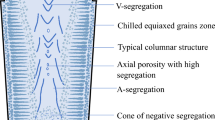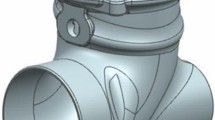Abstract
Microporosity prediction is very important for the production of complex-shaped superalloy investment castings in the aviation industry. In this study, the dimensionless Niyama criterion developed by Kent D.Carlson was used for microporosity prediction in nickel-based superalloy investment casting. The solid fraction-temperature curve and the total solidification shrinkage of the alloy were calculated using JMatPro software. Relationship between the volume percentage of microporosity and the dimensionless Niyama values were constructed. At the same time, Quantitative Metallographic measurements of the microporosity of the practical thin-wall casting were carried out. The results showed that the prediction agreed well with the experiment in general, except for some thick-wall sites in the casting.
Access this chapter
Tax calculation will be finalised at checkout
Purchases are for personal use only
Preview
Unable to display preview. Download preview PDF.
Similar content being viewed by others
References
Reed, R. C., The superalloys: fundamentals and applications (Oxford, Cambridge Univ Pr, 2006), 1–28.
Sung, P. K. et al., “Simulations of microporosity in IN718 equiaxed investment castings,” Journal of Crystal Growth, 226 (2–3)(2001), 363–377.
Campbell, J, “On the Origin of Porosity in Long Freezing-Range Alloys,” BRIT FOUNDRYMAN, 62 (4)(1969), 147–158.
Kubo, K., Pehlke, R.D., “Mathematical modeling of porosity formation in solidification,” Metallurgical and Materials Transactions B, 16 (2)(1985), 359–366.
Zuo, Y et al., “Refining grain structure and porosity of an aluminium alloy with intensive melt shearing,” Scripta Materialia, 64 (2)(2011), 209–212.
Yong. G et al., “Prediction and improvement of shrinkage porosity in TiAl based alloy,”Research & Development, (2011), 19–24.
Drenchev, L et al., “A comprehensive model of ordered porosity formation,” Acta Materialia 55 (19)(2007), 6459–6471.
Lee, P. D, Hunt, J. D, “H ydro gen porosity in directio nall y solidified aluminium-c o pper allo ys: A mathematical model,” Acta Materialia, 49 (8)(2001), 1383–1398.
Atwood, R. C, Lee, P. D, “Simulation of the three-dimensional morphology of solidification porosity in an aluminium-silicon alloy,” Acta Materialia, 51 (18)(2003), 5447–5466.
Lesoult, G, “Microporosity in cast alloys: simple considerations on its formation,” International Journal of Cast Metals Research, 22 (1–4)(2009), 2–7.
Stefanescu, D. M, “Computer simulation of shrinkage related defects in metal castings – a review, ” International Journal of Cast Metals Research, 18 (3)(2005), 129–143.
Wang, J. S, Lee, P. D, “Simulating tortuous 3D morphology of microporosity formed during solidification of Al-Si-Cu alloys,” International Journal of Cast Metals Research,20 (3)(2007), 151–158.
Chen, Q et al., “Porosity reduction by minor additions in RR2086 superalloy,” Scripta Materialia, 51 (2)(2004), 155–160.
Melo, M. L. N, Rizzo, E and Santos, R, “Numeral simulation application in microporosity prevision in aluminum alloy castings,” Revista Brasileira de Aplica es de V¨¢cuo,24 (1)(2005), 36–42.
Xue, X, Li, H. W, “Influence of pressure on shrinkage porosity prediction,” Transactions of the Nonferrous Metals Society of China, (15) 2005, 217–221.
Pequet, C, Rappaz, M, and Gremaud, M, “Modeling of microporosity, macroporosity, and pipe-shrinkage formation during the solidification of alloys using a mushy-zone refinement method: Applications to aluminum alloys,” Metallurgical and Materials Transactions A 33 (7)(2002), 2095–2106.
Lecomte-Beckers, J, “Study of microporosity formation in nickel-base superalloys,” Metallurgical and Materials Transactions A, 19 (9)(1988), 2341–2348.
Lee, P, Chirazi, A, and See, D, “Modeling microporosity in aluminum-silicon alloys: a review,” Journal of Light Metals, 1 (1)(2001), 15–30.
Kim, J. R, Abbaschian, R, “Influence of solidification variables on the microporosity formation on Al-Cu (4.5 wt%) alloy with axial heat processing,” Journal of Materials Science, 46 (19)(2011), 6213–6223.
Shang, L et al., “Development of a New Criteria Function to Predict Microporosity in 319 Al-Si Castings,” Proceedings. Cast Expo,(2005), 1–22.
Carlson, K. D., Beckermann, C, “Prediction of Shrinkage Pore Volume Fraction Using a Dimensionless Niyama Criterion,” Metallurgical and Materials Transactions A,40 (1)(2009),163–175.
K. Fisher, W. Kurz, Fundamentals of solidification (Lausanne, Trans Tech Publications, 1984), 85–92
Author information
Authors and Affiliations
Editor information
Editors and Affiliations
Rights and permissions
Copyright information
© 2013 TMS (The Minerals, Metals & Materials Society)
About this paper
Cite this paper
Wang, J. (2013). Prediction of Microporosity in Complex Thin-Wall Castings with the Dimensionless Niyama Criterion. In: Marquis, F. (eds) Proceedings of the 8th Pacific Rim International Congress on Advanced Materials and Processing. Springer, Cham. https://doi.org/10.1007/978-3-319-48764-9_319
Download citation
DOI: https://doi.org/10.1007/978-3-319-48764-9_319
Publisher Name: Springer, Cham
Print ISBN: 978-3-319-48586-7
Online ISBN: 978-3-319-48764-9
eBook Packages: Chemistry and Materials ScienceChemistry and Material Science (R0)




